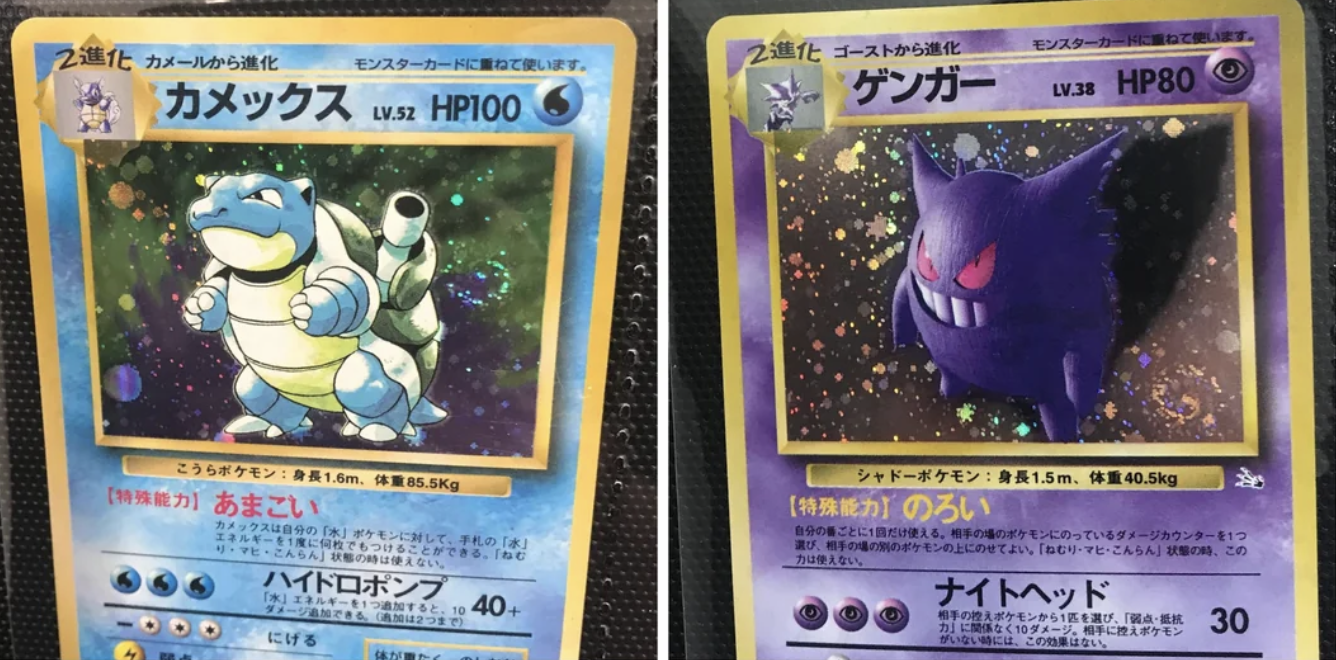The “Swirl” Buying Guide
Can you see the swirls on the right side in both of these Japanese holos?
Have you ever noticed something particularly fun about one of your vintage holos?
In the context of Pokémon cards, a “swirl” refers to a visual pattern in the holographic foil, usually on Holo Rare cards from older sets (like Base Set, Jungle, Fossil, and early WOTC-era cards). It’s a circular or spiral-shaped mark that appears in the holo background, and collectors often consider it a desirable feature.
Key points about swirls:
• They’re purely aesthetic — they don’t affect gameplay or card rarity.
• Swirls are random — caused by how the holofoil sheets were printed and cut.
• Placement matters — collectors often value swirls more when they appear in prominent places (like near the Pokémon’s face or attack).
• Cards with “double swirls” or “perfectly placed swirls” can command a premium.
• They are especially prized in slabbed vintage cards by PSA/BGS/CGC collectors.
⸻
The Swirl Effect: A Buyer’s Guide for Swirled Pokémon Cards
Swirls — those elusive spiral patterns in vintage holofoil Pokémon cards — have captured the attention of collectors everywhere. While they don’t appear in official pricing tools like TCGplayer or PSA Pop Reports, swirls can add a premium in the right circles. This guide breaks down how to evaluate and price swirled cards fairly — whether you’re a seller looking to comp your card, or a buyer trying to make a confident offer.
⸻
What Is a Swirl?
A swirl is a small, circular pattern in the holofoil background of certain Pokémon cards, most commonly from WOTC-era (Wizards of the Coast) sets like Base, Jungle, Fossil, and Neo. They appear randomly and can land anywhere on the holo area — some near the artwork, others tucked in corners.
• They do not impact gameplay or card rarity.
• They are not officially documented.
• They can influence market desirability and pricing.
⸻
For Sellers: How to Comp Cards with Swirls
1. Start with the Card’s Baseline Value
Use tools like:
• eBay sold listings (search “[Card Name] PSA 9 Holo” or raw if ungraded)
• TCGplayer / PriceCharting (for average raw sales)
• PWCC, Goldin, or Heritage (for slabbed comps on high-end items)
Example: A PSA 9 Holo Base Set Gyarados might typically sell for $110
⸻
2. Identify the Swirl’s Position and Appeal
Ask:
• Is the swirl prominent or hidden?
• Is it over the character or near the attack box?
• Is there more than one swirl? (Double swirl = rare + desirable)
Cards with:
• Swirls near the face, body, or attack usually command more attention
• Swirls in dark, busy corners may go unnoticed and add little value
⸻
3. Adjust Pricing Based on Swirl Tier
There’s no hard math, but here’s a reasonable premium structure for swirled cards:
Swirl Type Suggested Premium Notes
Hidden/Corner Swirl +$0–10 Minor bump, mostly cosmetic
Centered or Prominent Swirl +$10–25 Moderate premium if raw; slightly more if slabbed
Double Swirl +$25–75+ Rare, adds collector cachet
“God Swirl” (face, eye, etc.) +$50–100+ Top-tier placement, often comped individually
Tip: Use eBay’s photo zoom feature to find swirl comps and check descriptions like “swirl holo” or “swirled Gyarados.”
For Buyers: How to Make a Confident Offer
1. Know the Card’s Base Value First
Before factoring in the swirl, be sure you’re up to date on:
• Average raw or graded prices for that card in similar condition
• The current market trend (climbing, flat, or falling)
⸻
2. Factor in Swirl Placement, But Stay Objective
Remember:
• Swirls are subjective — what one buyer loves, another may not care about.
• A visible and centered swirl might be worth the premium — but only if you care about aesthetics.
• Ask yourself: Would I pay the same price if it didn’t have the swirl?
⸻
3. How Much Should You Offer?
Swirl Impact Offer Strategy
Minor swirl or hard-to-see Base value or 5–10% over
Centered swirl +10–25% max over base price
Double swirl or special placement Case-by-case; up to +50% if truly unique and desirable
Slabbed with swirl visible on front Add premium only if swirl is clear
Bottom Line: Swirls are a bonus, not a rule. Only pay the premium if you value it.
Final Tip: Use Swirls as a Negotiation Edge
• Buyers: Use the swirl as leverage when the base value feels high.
• Sellers: Use a clear, zoomed photo of the swirl — it can make the card stand out.
⸻
Bonus Suggestion: Label Your Listings Clearly
For sellers:
• Title Example: Gyarados Holo – Base Set – PSA 9 – SWIRL Near Head
• Add arrows or highlights in your images to make the swirl easy to spot.
For buyers:
• Search using terms like swirl, swirled holo, or double swirl on eBay and marketplace sites to narrow down to swirl-visible cards.
